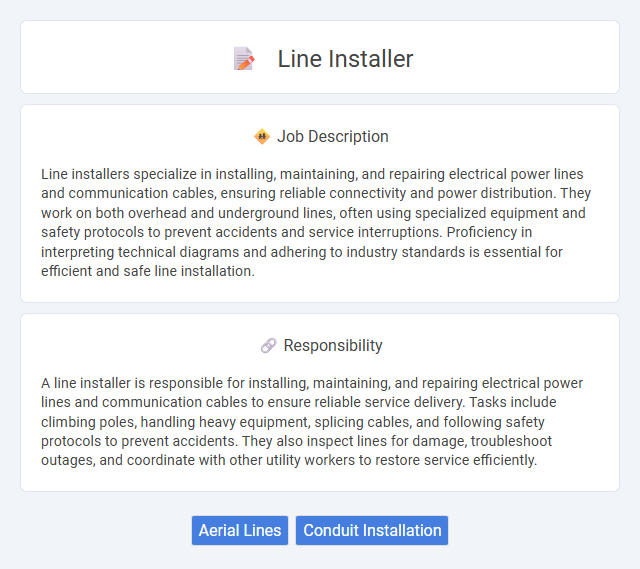
Line installers specialize in installing, maintaining, and repairing electrical power lines and communication cables, ensuring reliable connectivity and power distribution. They work on both overhead and underground lines, often using specialized equipment and safety protocols to prevent accidents and service interruptions. Proficiency in interpreting technical diagrams and adhering to industry standards is essential for efficient and safe line installation.
Line installers likely face physically demanding and sometimes hazardous conditions, requiring strong attention to safety protocols and physical stamina. Individuals with good problem-solving skills, comfort with heights, and the ability to work in varying weather conditions are probably more suitable for this job. Those who may struggle with physical exertion or fear of heights might find this role challenging and less appropriate for their abilities.
Qualification
Line installers require a high school diploma or equivalent, with specialized training in electrical theory, safety protocols, and equipment handling essential for job performance. Certification such as the OSHA 10 or 30-hour Construction Safety course and a Commercial Driver's License (CDL) are often mandated by employers. Apprenticeship programs combining classroom instruction and on-the-job training typically span 3 to 4 years, ensuring comprehensive skill development in installing, maintaining, and repairing electrical power or telecommunications lines.
Responsibility
A line installer is responsible for installing, maintaining, and repairing electrical power lines and communication cables to ensure reliable service delivery. Tasks include climbing poles, handling heavy equipment, splicing cables, and following safety protocols to prevent accidents. They also inspect lines for damage, troubleshoot outages, and coordinate with other utility workers to restore service efficiently.
Benefit
Line installer jobs likely offer competitive wages paired with comprehensive benefits such as health insurance and retirement plans, enhancing overall financial security. The role may provide opportunities for skill development and career advancement through specialized training programs. Workers might also benefit from job stability and demand in the energy and telecommunications sectors, suggesting a promising employment outlook.
Challenge
Line installer jobs likely involve significant challenges due to working at heights and in varying weather conditions, requiring strong physical endurance and safety awareness. There is a probability of encountering complex technical issues with electrical lines that demand problem-solving skills and quick decision-making. The role may also involve coordinating with teams under time-sensitive situations, increasing the need for effective communication and adaptability.
Career Advancement
Line installer jobs offer a clear path for career advancement through gaining specialized certifications and on-the-job experience with fiber optics, electrical, and telecommunications systems. Progression often leads to supervisory or project management roles, where expertise in system installation and maintenance becomes critical. Continuous training in new technologies enhances qualifications, increasing opportunities for higher pay and leadership positions within utility and telecommunications companies.
Key Terms
Aerial Lines
Line installers specializing in aerial lines are responsible for constructing, maintaining, and repairing overhead power and telecommunication cables. Their tasks include climbing poles, using specialized equipment to ensure proper cable tension, and following safety protocols to prevent electrical hazards. Expertise in reading technical diagrams and understanding electrical systems is essential for efficient aerial line installation and troubleshooting.
Conduit Installation
Line installers specialize in conduit installation, ensuring secure and efficient pathways for electrical and communication cables. They carefully measure, cut, and join conduit pipes, often working with materials such as PVC, steel, or aluminum to protect wiring from environmental hazards. Expertise in interpreting blueprints and applying grounding techniques is crucial for maintaining safety and compliance with industry standards.
 kuljobs.com
kuljobs.com